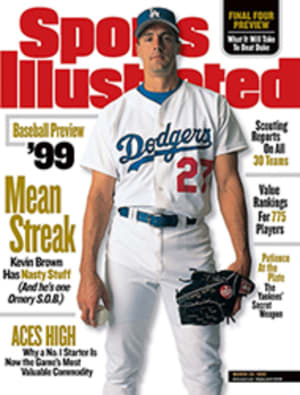
Boom With A View Sports on TV 24/7--it doesn't get any better than that, right? That's what they said about the market in '29
Back in the days when Dad did the yard work in a cardigan,
sports television seemed pretty simple. On weeknights you did
homework and watched Wagon Train. On weekends you cleaned the
garage and then waited for Mom to serve the roast. While you
waited, you watched sports. By the time you finished dinner,
sports was over and it was time for Bonanza.
These days, sports is never over. And that's what's going to
kill it. Next year, in the four major leagues alone (MLB, NFL,
NBA and NHL), 4,974 games will be played. Not including
playoffs, this is an average of 13.6 games per day. Most of them
will be televised somewhere, locally, regionally or nationally.
(Better set that VCR!) If you have cable or a satellite dish,
add at least three round-the-clock "sports news" channels. Be
sure to include a couple thousand hours for golf and bowling and
auto racing on your calendar, too. (You're going to need way
more tape.) And soccer, what about soccer? Or figure skating and
bass fishing and tennis! Curling! Hurling! Semipro baton
twirling! To say nothing of make-believe sports like street luge
and all things "extreme." Cheerleading! The World's Strongest
Man! The Global Aerobics Fitness and Lung Capacity
Championships! Box lacrosse! And the colleges! We forgot the
colleges! Double everything I just said!
The hypergigantism of American sports started when the networks,
their affiliates and team owners began speculating on sports
television as if it were the 1929 stock market. For years,
sports and TV maintained a workable economy in which the team
owners, the broadcasters and the players all made progressively
more money and fans were left, for the most part, unscrewed by
spiraling ticket prices and $7 dogs. The rampant overexpansion
wasn't possible until cable came along. A 70-channel cable
system has 613,200 hours of programming to fill every year.
While this provides opportunities for greater diversity (the
American Wallyball Finals!), cable's ravenous appetite for
content and its atomization of the audience spells trouble for
sports fans. Too many teams in too many sports in too many
markets paying too much money for too many players; all of it
underwritten by absurdly inflated national television contracts.
The networks have gone begging to their affiliates to lay off
some of the cost of multi-billion-dollar sports contracts.
(Advertising can bring in only so much...until America embraces
the $50 six-pack.) The NBA lockout happened because owners
finally realized that they'd created an unsustainable economic
model. Like a pyramid scheme gone sour, there was no longer
enough money coming in at the bottom to pay off the guys at the
top--especially since the guy at the top is no longer Michael
Jordan.
When the overheated expansion economy created by television
cools, marginal franchises are going to be in trouble. Hockey in
Tampa? Not unless they charge $1,500 a seat to a busload of
vacationing Canadians. Sadly, some of your favorite small-market
teams will be dragged down in the aftersuck. Baseball in
Milwaukee and Pittsburgh? Without revenue sharing? Not for long.
So the sports junkies got their wish--all sports, all the
time--but we're all going to suffer for it when the market
crashes. And it will, unless players and owners agree to take a
lot less money. Which they won't do. When this house of cards
comes down, and traditional sports are pay-per-view only, what
can we groundlings expect to see on free TV? Are you ready for
Rupert Murdoch's Indonesian Kickboxing Satellite Network?
Let me know. I'll be out in the garage.
COLOR ILLUSTRATION: DAN PICASSO

